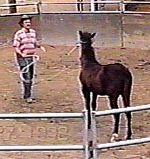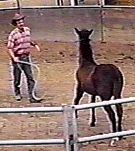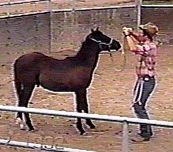|
In Part Two we discussed the basics of handling the line
efficiently. Now we'll try some maneuvers.
Part of teaching a horse to stay out of your space involves getting him to
back up on your cue. The cue we use involves energy. We may be walking the horse
on lead and we need him not to crowd us if he gets distracted or excited.
In other situations, we need to back the horse away with the movement of our
hands. The longe line provides us with a good opportunity for teaching
good backing habits, which incidentally carry over to saddle work.
 This maneuver works best with proper equipment; a 12 foot long 5/8" to 3/4" marine grade kernmantle braid horse handling rope and a supple kernmantle braid hand tied rope halter. This particular equipment has the proper weight and feel to elicit a reliable response. The idea here is to send the horse backwards with our energy which will also transmit some sensations to the nerves which run along the bridge of the horse's nose. These sensations don't hurt the horse, but annoy him. He will want to avoid the stimulus and the energy being sent down the rope will suggest that he move backward.
This maneuver works best with proper equipment; a 12 foot long 5/8" to 3/4" marine grade kernmantle braid horse handling rope and a supple kernmantle braid hand tied rope halter. This particular equipment has the proper weight and feel to elicit a reliable response. The idea here is to send the horse backwards with our energy which will also transmit some sensations to the nerves which run along the bridge of the horse's nose. These sensations don't hurt the horse, but annoy him. He will want to avoid the stimulus and the energy being sent down the rope will suggest that he move backward.
We pay out most of the rope with some float in the line and with the horse facing
us, we'll shake the rope back and forth. We'll try to "throw" the ripples down the line. We don't pull and shake the rope as that will tend to make the horse want to approach us. When we first attempt this he will likely raise his head or look away. (Note: Shaking the rope will not make him high headed or head shy. He is responding to specific stimulation here.)
If he turns away, we'll draw him back around to face us and we'll repeat the cue. The INSTANT he rocks or attempts to take a step backwards, we'll stop shaking the rope. After a few repetitions he'll discover that he can make us stop shaking the rope by moving backward. We just ask for a little movement at first, rewarding even the slightest tries. Our initial approach is like we're trying to make him think he's teaching us to stop shaking the rope by his stepping backwards.
 If the horse tunes us out, we may have to get pretty assertive with the rope. The bull snap may even clunk him on the lower jawbone. Unless we are violent with this (which we aren't), we're not going to hurt him. As the horse gets the concept, we will expend less energy shaking the rope and direct him more with our stance and motion. Our goal is to more or less bring him to attention with the shaking and prepare him to back up, and keep him moving with a minimum of motion of the rope and more through our body actions. Note the slight difference
in this second picture which was taken a few seconds after the first. I'm stepping forward a little and the horse is stepping back.
If the horse tunes us out, we may have to get pretty assertive with the rope. The bull snap may even clunk him on the lower jawbone. Unless we are violent with this (which we aren't), we're not going to hurt him. As the horse gets the concept, we will expend less energy shaking the rope and direct him more with our stance and motion. Our goal is to more or less bring him to attention with the shaking and prepare him to back up, and keep him moving with a minimum of motion of the rope and more through our body actions. Note the slight difference
in this second picture which was taken a few seconds after the first. I'm stepping forward a little and the horse is stepping back.
This is one maneuver where many people find it difficult to grip the rope with their little fingers toward the halter. If it feels awkward to you, reverse your hand position so that your palm is up and thumb out, kind of like holding a golf club. When you do this, however, practice pinching the rope between your thumb and index finger and rocking your hand around so that you can instantly reverse your grip by placing your other three fingers over the rope and gripping it
"pinky out" again in case the horse gets strong. (This movement sounds complicated, but if you break it down into steps, you will find it not so difficult.)
 We can also back the horse with our hands. By folding the rope and holding it in both hands, we can build a moving "wall." The horse can't turn because we have left him just enough slack in the rope to move away from us but not enough to turn around. By wiggling our hands up and down, one hand moving up while the other moves down and vice-versa, we're sending a pretty clear message. As with backing down the rope, we will reward the slightest try in the beginning, expecting better movement as the horse figures out the cue. Later we can "wave" the horse back with just the motion of a hand should we need to since the horse will be attentive to our gesture.
We can also back the horse with our hands. By folding the rope and holding it in both hands, we can build a moving "wall." The horse can't turn because we have left him just enough slack in the rope to move away from us but not enough to turn around. By wiggling our hands up and down, one hand moving up while the other moves down and vice-versa, we're sending a pretty clear message. As with backing down the rope, we will reward the slightest try in the beginning, expecting better movement as the horse figures out the cue. Later we can "wave" the horse back with just the motion of a hand should we need to since the horse will be attentive to our gesture.
The next part will discuss teaching the horse to yield.
Important Note: If you take on the project of
developing an untrained horse, everybody will want to give you advice.
Don't act on any advice, including the ideas offered in this site,
unless it makes sense to you and fits your individual situation. Your
abilities and the sensitivities of your horse(s) may differ from the
examples given. Be alert and rational with your actions so neither you nor
your horse will get hurt. This information is offered as illustrations of
what we do and the reader must apply common sense since he or she is solely
responsible for his or her actions.
Happy trails!
Press "Back" to return to the page that brought you here
KBR Horse Training Information, © 1997
Lamm's Kickin' Back Ranch and Willis & Sharon Lamm. All rights reserved. Duplication of any of
this material for commercial use is prohibited without express written permission.
This prohibition is not intended to extend to personal non-commercial use, including sharing
with others for safety and learning purposes, provided this copyright notice is
attached.
Email us to submit comments or
request reproduction permission.
| 
 This maneuver works best with proper equipment; a 12 foot long 5/8" to 3/4" marine grade kernmantle braid horse handling rope and a supple kernmantle braid hand tied rope halter. This particular equipment has the proper weight and feel to elicit a reliable response. The idea here is to send the horse backwards with our energy which will also transmit some sensations to the nerves which run along the bridge of the horse's nose. These sensations don't hurt the horse, but annoy him. He will want to avoid the stimulus and the energy being sent down the rope will suggest that he move backward.
This maneuver works best with proper equipment; a 12 foot long 5/8" to 3/4" marine grade kernmantle braid horse handling rope and a supple kernmantle braid hand tied rope halter. This particular equipment has the proper weight and feel to elicit a reliable response. The idea here is to send the horse backwards with our energy which will also transmit some sensations to the nerves which run along the bridge of the horse's nose. These sensations don't hurt the horse, but annoy him. He will want to avoid the stimulus and the energy being sent down the rope will suggest that he move backward.
 If the horse tunes us out, we may have to get pretty assertive with the rope. The bull snap may even clunk him on the lower jawbone. Unless we are violent with this (which we aren't), we're not going to hurt him. As the horse gets the concept, we will expend less energy shaking the rope and direct him more with our stance and motion. Our goal is to more or less bring him to attention with the shaking and prepare him to back up, and keep him moving with a minimum of motion of the rope and more through our body actions. Note the slight difference
in this second picture which was taken a few seconds after the first. I'm stepping forward a little and the horse is stepping back.
If the horse tunes us out, we may have to get pretty assertive with the rope. The bull snap may even clunk him on the lower jawbone. Unless we are violent with this (which we aren't), we're not going to hurt him. As the horse gets the concept, we will expend less energy shaking the rope and direct him more with our stance and motion. Our goal is to more or less bring him to attention with the shaking and prepare him to back up, and keep him moving with a minimum of motion of the rope and more through our body actions. Note the slight difference
in this second picture which was taken a few seconds after the first. I'm stepping forward a little and the horse is stepping back.
 We can also back the horse with our hands. By folding the rope and holding it in both hands, we can build a moving "wall." The horse can't turn because we have left him just enough slack in the rope to move away from us but not enough to turn around. By wiggling our hands up and down, one hand moving up while the other moves down and vice-versa, we're sending a pretty clear message. As with backing down the rope, we will reward the slightest try in the beginning, expecting better movement as the horse figures out the cue. Later we can "wave" the horse back with just the motion of a hand should we need to since the horse will be attentive to our gesture.
We can also back the horse with our hands. By folding the rope and holding it in both hands, we can build a moving "wall." The horse can't turn because we have left him just enough slack in the rope to move away from us but not enough to turn around. By wiggling our hands up and down, one hand moving up while the other moves down and vice-versa, we're sending a pretty clear message. As with backing down the rope, we will reward the slightest try in the beginning, expecting better movement as the horse figures out the cue. Later we can "wave" the horse back with just the motion of a hand should we need to since the horse will be attentive to our gesture.